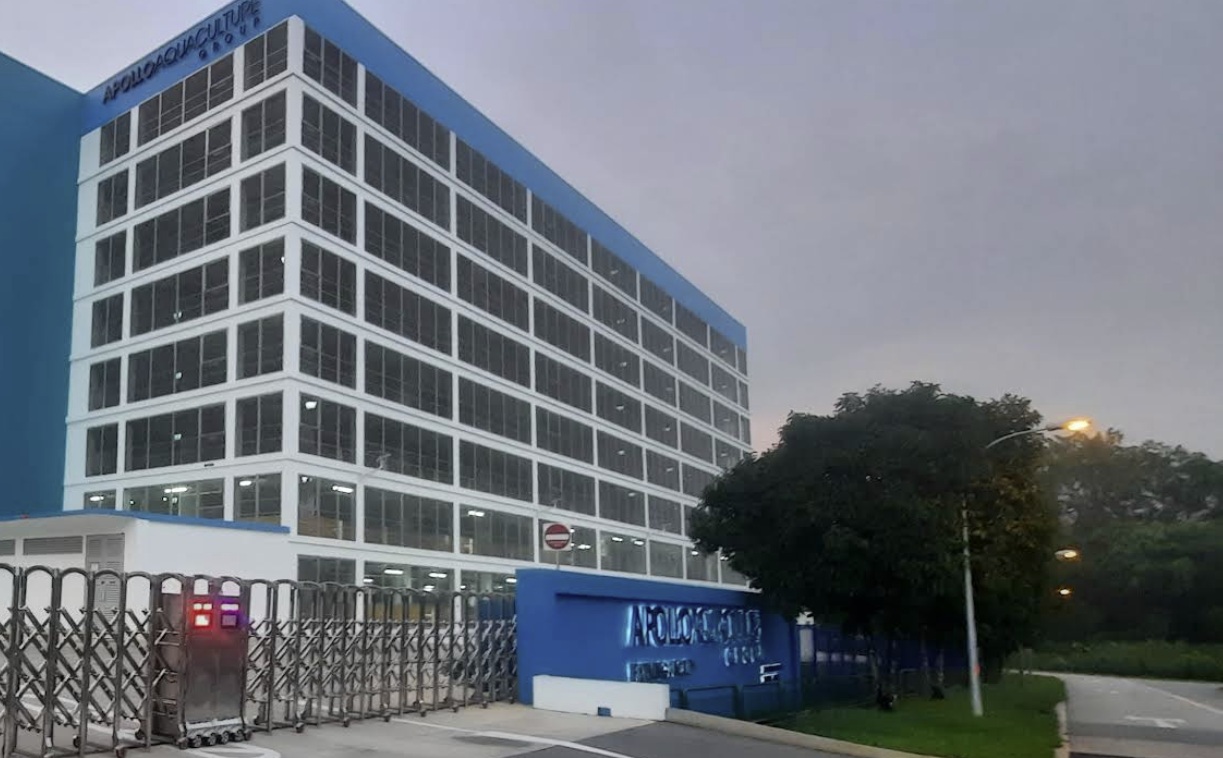AquaChamp and HPC have acquired Apollo Aquaculture’s 8‑storey vertical fish farm in Lim Chu Kang, while Singapore Aquaculture Technologies (SAT) is taking over deep‑sea net cages off St John’s Island. These moves mark a major reshaping of Singapore’s aquaculture sector after several high‑profile farm closures.

Eight-storey vertical farm
Singapore’s Straits Times has reported that AquaChamp, a land-based fish farm operator, and local construction and engineering firm HPC Builders have taken over the S$65 million farm once owned by Apollo Aquaculture Group. The building at Neo Tiew Crescent in Lim Chu Kang will be used to grow vannamei prawn and food fish. Apollo ran into financial difficulties in 2022.
On the new plans, AquaChamp spokesperson told Straits Times, that the first six floors will focus on fish production, and vannamei shrimp will be farmed on levels 7&8.
“We will utilise three storeys first, and gradually increase production level by level,” the spokesperson told the Straits Times.
Farming of fish and shrimp has started, said AquaChamp, after its engineering team installed the equipment and farming systems. It added that the amount of seafood currently farmed is “not too high”, as the company is still in the midst of revamping the recirculating aquaculture system.
It is also looking at selling ready-to-eat products to meet the needs of busy customers.
“The design is unique and built to suit our climate. We strongly believe in its potential, and will work hard to make this a proud Singapore brand,” said AquaChamp.
The firm’s management saw the potential and the benefits of farming in the facility, and Apollo’s building was acquired “after careful consideration”, said the spokesperson.
When Apollo Aquaculture Group began operations in 2021, the facility was showcased as a high-tech farming solution that addressed the Republic’s land-scarcity constraints. However, it had been lying dormant since the group ran into financial difficulties and was placed under judicial management in May 2022.
In 2024, it was reported that HPC Builders would purchase 70% of Apollo”s equity for not more than S$3.5 million, while the remaining 30% was sold AquaChamp.
“Without scale in farming, you are not going to be successful, and we need to grow the largest-size fish for export. Large fish grown in RAS (recirculating aquaculture systems) are not as economical because the fish slows down in its growth rate. RAS is also expensive to run.”
“A lot of money, time and effort was spent installing (Barramundi Group’s) assets. It would be a great shame just to leave that. We also have a different farming technique that gives us a better chance to be successful with those assets,” he added.
SAT will take over 10ha of the sea area, which will include the deep-sea cages, the two barges, floating solar panels and a battery storage barge. To improve the quality of fish farmed, the firm will also run a seabass hatchery and nursery at the Singapore Food Agency’s Marine Aquaculture Centre on the island. SAT will continue growing red snapper and grouper at its indoor barge in the East Johor Strait. Barramundi Group’s open-sea cages off Pulau Senang and Pulau Semakau will not be taken over by SAT
Singapore’s waters are known to harbour viruses and parasites that affect fish mortality. Barramundi Group’s fish were affected by the scale drop disease virus, which can be fatal to seabass. Voigtmann said that the fish’s immune system will be more developed. By the time it is around 700g, it’s a pretty robust fish and has a much higher chance to be able to manage whatever it sees in the sea.”

Scaling-down goals
On November 4, 2025, the government said it will scrap the original 30 by 30 farming target of producing 30% food consumed in Singapore locally by 2030, for revised, scaled-down goals. The aim now is to produce 20% of the country’s consumed fibre, such as leafy vegetables, and 30 per cent of protein, including seafood and eggs, by 2035.




